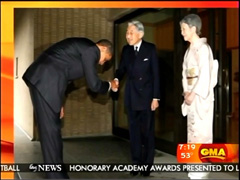ABC Omits Critics of Obama's 'Jarring and Inappropriate' Bow; Sawyer Says Protocol 'Too Confusing'

ABC's Good Morning America finally picked up on the deep bow
President Obama performed for the Emperor of Japan over the weekend.
Co-host Diane Sawyer ran through how other U.S. Presidents have greeted
either Emperor Akhito or his father, the late Emperor Hirohito over the
years - some bowing, some not. Sawyer claimed that Americans are "not
trained to greet royalty" and "it's just too confusing."
Actually, the government employs lots of experts on culture and
protocol to make sure that our presidents are fully "trained" on what
to do when they represent our government overseas - which is not to say
that all of our presidents perform these duties flawlessly.
Missing from Sawyer's run-down is a tidbit that ABC White House correspondent Jake Tapper posted on his "Political Punch" blog
Sunday afternoon. Tapper said he received a note from an old friend
whom he described as "an academic with expertise about the Japanese
Empire, and in general a supporter of President Obama." According to
this expert, it wasn't necessarily incorrect for Obama to bow, but the
President's "forward lurch" was "jarring and inappropriate."
The expert described the bow as "in the form of a first year English
teacher trying to impress with Karate Kid-level knowledge of Japanese
customs. The bow as he performed did not just display weakness in Red
State terms, but evoked weakness in Japanese terms." He noted also that
Japan's Kyodo News emphasized footage of Obama's more restrained bow to
the Emperor's wife, pictures that "show the president as dignified."
Here's Sawyer on Monday morning's Good Morning America, as transcribed by the MRC's Scott Whitlock:
DIANE SAWYER: And before we leave the topic of the president's trip overseas I've often thought the hardest subject for every President, what do you do with royalty? We're not trained to greet royalty since 1776. [Onscreen photo of Obama bowing.] The President, as we saw with the emperor, went the full way, lots of comment about that. But we look back over the years and you have, of course, George Bush, former president George Bush Sr. there, head nod. There was Ronald Reagan, hand shake. [Pictures appear onscreen.]
ROBIN ROBERTS: Hand shake. That's always good.
SAWYER: Richard Nixon went from the waist [Nixon appears to be leaning in.] and Bill Clinton, what was that? [Picture of Clinton clasping his hands, could be clapping.] Kind of yoga thing there. Anyway who can blame them for not knowing what to do? Allegedly, Teddy Roosevelt said once "If I see another king I'm going to bite him." It's just too confusing when you're American.
That Teddy Roosevelt quote, by the way, came from a 1994 New York Times "Week in Review" item
that made the rounds this weekend after Obama's bow. If Sawyer read the
whole item - related the controversy over then-President Clinton's
much milder bow before the Emperor - she would have learned that
there's not that much "confusion" over American protocol. According to
the Times (then): "the 'thou need not bow' commandment from the State
Department's protocol office maintained a constancy of more than 200
years."
A Washington Post item from that same week (retrieved via Nexis)
quoted Clinton's top protocol officer talking about the arrangements
for Emperor Akihito's state visit to Washington: "'Americans do not
bow,' said Chief of Protocol Molly Raiser. 'The emperor is known to
shake hands. This emperor is much more informal than his father was.'"
Monday's New York Times
briefly mentioned the bow controversy, blaming it on the "conservative
American bloggers" who critized Obama. "'During his meetings and his
speech in Tokyo, the President observed protocol and enhanced the
status of American interests in Japan and across Asia,' said an
administration official traveling with the President, who spoke on the
condition of anonymity according to protocol. 'Those who suggest
otherwise are way off base and only looking to score political
points.'"
-Rich Noyes is Research Director at the Media Research Center.





